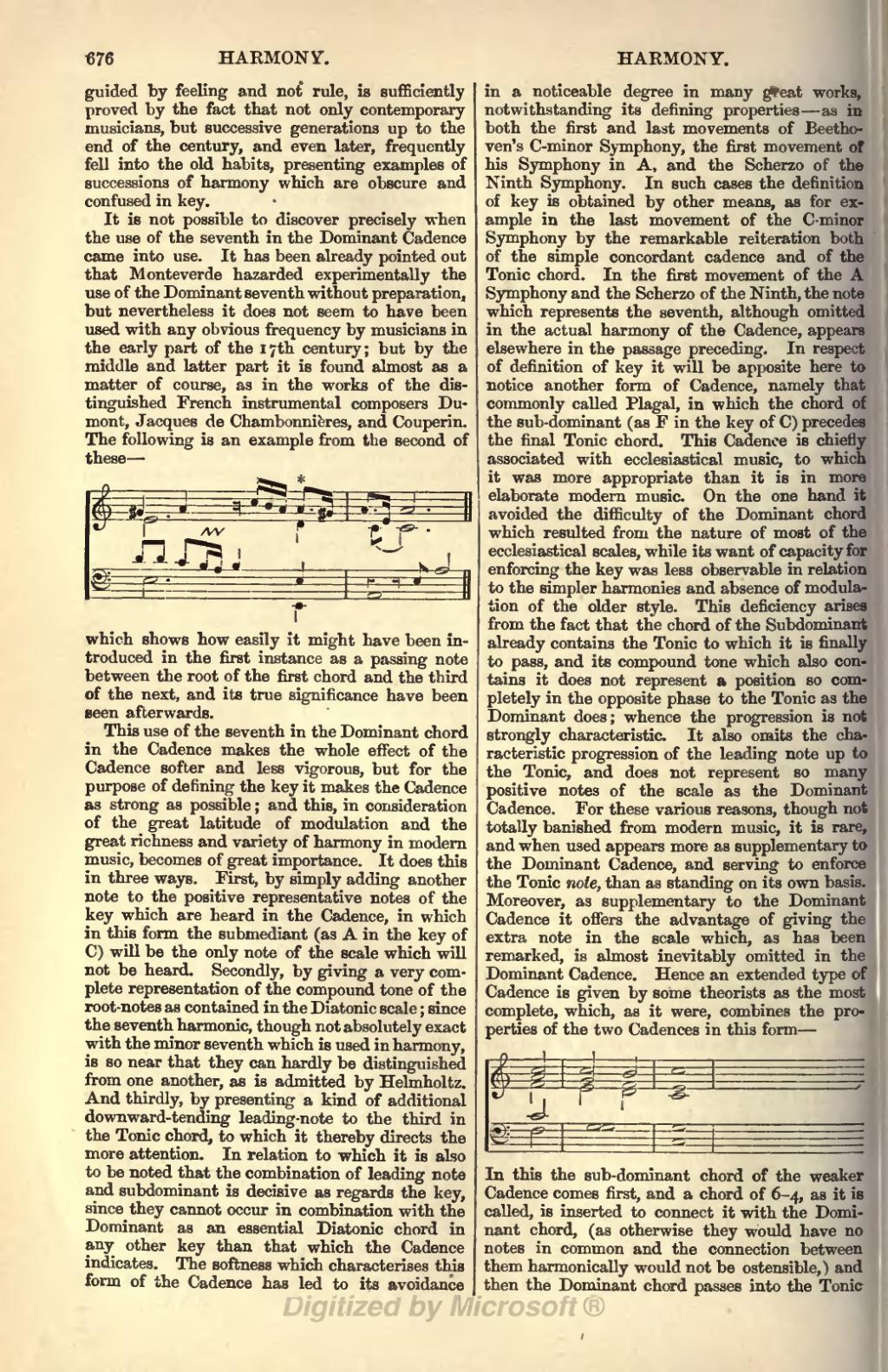guided by feeling and not rule, is sufficiently proved by the fact that not only contemporary musicians, but successive generations up to the end of the century, and even later, frequently fell into the old habits, presenting examples of successions of harmony which are obscure and confused in key.
It is not possible to discover precisely when the use of the seventh in the Dominant Cadence came into use. It has been already pointed out that Monteverde hazarded experimentally the use of the Dominant seventh without preparation, but nevertheless it does not seem to have been used with any obvious frequency by musicians in the early part of the 17th century; but by the middle and latter part it is found almost as a matter of course, as in the works of the distinguished French instrumental composers Dumont, Jacques de Chambonnieres, and Couperin. The following is an example from the second of these—

which shows how easily it might have been introduced in the first instance as a passing note between the root of the first chord and the third of the next, and its true significance have been seen afterwards.
This use of the seventh in the Dominant chord in the Cadence makes the whole effect of the Cadence softer and less vigorous, but for the purpose of defining the key it makes the Cadence as strong as possible; and this, in consideration of the great latitude of modulation and the great richness and variety of harmony in modern music, becomes of great importance. It does this in three ways. First, by simply adding another note to the positive representative notes of the key which are heard in the Cadence, in which in this form the submediant (as A in the key of C) will be the only note of the scale which will not be heard. Secondly, by giving a very complete representation of the compound tone of the root-notes as contained in the Diatonic scale; since the seventh harmonic, though not absolutely exact with the minor seventh which is used in harmony, is so near that they can hardly be distinguished from one another, as is admitted by Helmholtz. And thirdly, by presenting a kind of additional downward-tending leading-note to the third in the Tonic chord, to which it thereby directs the more attention. In relation to which it is also to be noted that the combination of leading note and subdominant is decisive as regards the key, since they cannot occur in combination with the Dominant as an essential Diatonic chord in any other key than that which the Cadence indicates. The softness which characterises this form of the Cadence has led to its avoidance in a noticeable degree in many great works, notwithstanding its defining properties—as in both the first and last movements of Beethoven's C-minor Symphony, the first movement of his Symphony in A, and the Scherzo of the Ninth Symphony. In such cases the definition of key is obtained by other means, as for example in the last movement of the C-minor Symphony by the remarkable reiteration both of the simple concordant cadence and of the Tonic chord. In the first movement of the A Symphony and the Scherzo of the Ninth, the note which represents the seventh, although omitted in the actual harmony of the Cadence, appears elsewhere in the passage preceding. In respect of definition of key it will be apposite here to notice another form of Cadence, namely that commonly called Plagal, in which the chord of the sub-dominant (as F in the key of C) precedes the final Tonic chord. This Cadence is chiefly associated with ecclesiastical music, to which it was more appropriate than it is in more elaborate modern music. On the one hand it avoided the difficulty of the Dominant chord which resulted from the nature of most of the ecclesiastical scales, while its want of capacity for enforcing the key was less observable in relation to the simpler harmonies and absence of modulation of the older style. This deficiency arises from the fact that the chord of the Subdominant already contains the Tonic to which it is finally to pass, and its compound tone which also contains it does not represent a position so completely in the opposite phase to the Tonic as the Dominant does; whence the progression is not strongly characteristic. It also omits the characteristic progression of the leading note up to the Tonic, and does not represent so many positive notes of the scale as the Dominant Cadence. For these various reasons, though not totally banished from modern music, it is rare, and when used appears more as supplementary to the Dominant Cadence, and serving to enforce the Tonic note, than as standing on its own basis. Moreover, as supplementary to the Dominant Cadence it offers the advantage of giving the extra note in the scale which, as has been remarked, is almost inevitably omitted in the Dominant Cadence. Hence an extended type of Cadence is given by some theorists as the most complete, which, as it were, combines the properties of the two Cadences in this form—

In this the sub-dominant chord of the weaker Cadence comes first, and a chord of 6–4, as it is called, is inserted to connect it with the Dominant chord, (as otherwise they would have no notes in common and the connection between them harmonically would not be ostensible,) and then the Dominant chord passes into the Tonic
